Author: Jason Brownlee
The MNIST handwritten digit classification problem is a standard dataset used in computer vision and deep learning.
Although the dataset is effectively solved, it can be used as the basis for learning and practicing how to develop, evaluate, and use convolutional deep learning neural networks for image classification from scratch. This includes how to develop a robust test harness for estimating the performance of the model, how to explore improvements to the model, and how to save the model and later load it to make predictions on new data.
In this tutorial, you will discover how to develop a convolutional neural network for handwritten digit classification from scratch.
After completing this tutorial, you will know:
- How to develop a test harness to develop a robust evaluation of a model and establish a baseline of performance for a classification task.
- How to explore extensions to a baseline model to improve learning and model capacity.
- How to develop a finalized model, evaluate the performance of the final model, and use it to make predictions on new images.
Let’s get started.
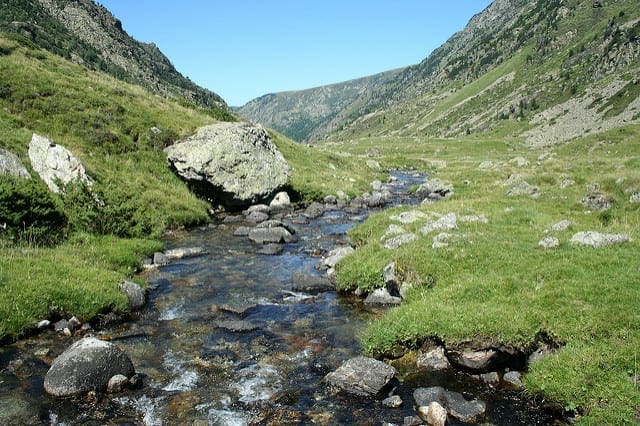
How to Develop a Convolutional Neural Network From Scratch for MNIST Handwritten Digit Classification
Photo by Richard Allaway, some rights reserved.
Tutorial Overview
This tutorial is divided into five parts; they are:
- MNIST Handwritten Digit Classification Dataset
- Model Evaluation Methodology
- How to Develop a Baseline Model
- How to Develop an Improved Model
- How to Finalize the Model and Make Predictions
Want Results with Deep Learning for Computer Vision?
Take my free 7-day email crash course now (with sample code).
Click to sign-up and also get a free PDF Ebook version of the course.
MNIST Handwritten Digit Classification Dataset
The MNIST dataset is an acronym that stands for the Modified National Institute of Standards and Technology dataset.
It is a dataset of 60,000 small square 28×28 pixel grayscale images of handwritten single digits between 0 and 9.
The task is to classify a given image of a handwritten digit into one of 10 classes representing integer values from 0 to 9, inclusively.
It is a widely used and deeply understood dataset and, for the most part, is “solved.” Top-performing models are deep learning convolutional neural networks that achieve a classification accuracy of above 99%, with an error rate between 0.4 %and 0.2% on the hold out test dataset.
The example below loads the MNIST dataset using the Keras API and creates a plot of the first nine images in the training dataset.
# example of loading the mnist dataset
from keras.datasets import mnist
from matplotlib import pyplot
# load dataset
(trainX, trainy), (testX, testy) = mnist.load_data()
# summarize loaded dataset
print('Train: X=%s, y=%s' % (trainX.shape, trainy.shape))
print('Test: X=%s, y=%s' % (testX.shape, testy.shape))
# plot first few images
for i in range(9):
# define subplot
pyplot.subplot(330 + 1 + i)
# plot raw pixel data
pyplot.imshow(trainX[i], cmap=pyplot.get_cmap('gray'))
# show the figure
pyplot.show()
Running the example loads the MNIST train and test dataset and prints their shape.
We can see that there are 60,000 examples in the training dataset and 10,000 in the test dataset and that images are indeed square with 28×28 pixels.
Train: X=(60000, 28, 28), y=(60000,)Test: X=(10000, 28, 28), y=(10000,)
A plot of the first nine images in the dataset is also created showing the natural handwritten nature of the images to be classified.
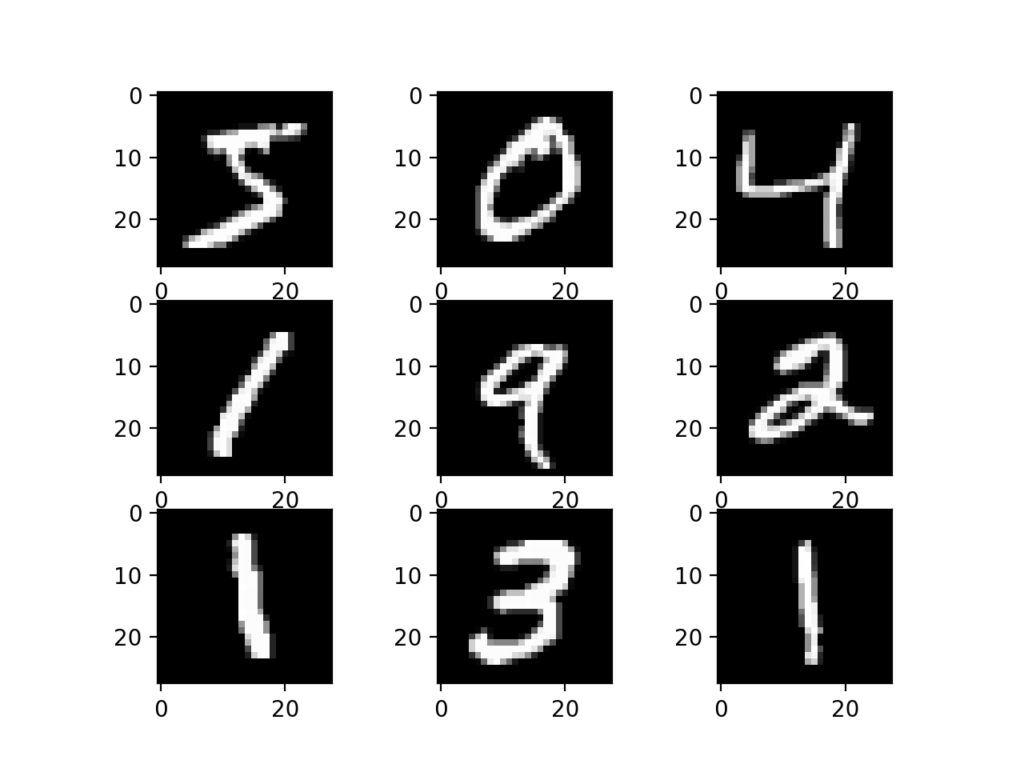
Plot of a Subset of Images From the MNIST Dataset
Model Evaluation Methodology
Although the MNIST dataset is effectively solved, it can be a useful starting point for developing and practicing a methodology for solving image classification tasks using convolutional neural networks.
Instead of reviewing the literature on well-performing models on the dataset, we can develop a new model from scratch.
The dataset already has a well-defined train and test dataset that we can use.
In order to estimate the performance of a model for a given training run, we can further split the training set into a train and validation dataset. Performance on the train and validation dataset over each run can then be plotted to provide learning curves and insight into how well a model is learning the problem.
The Keras API supports this by specifying the “validation_data” argument to the model.fit() function when training the model, that will, in turn, return an object that describes model performance for the chosen loss and metrics on each training epoch.
# record model performance on a validation dataset during training history = model.fit(..., validation_data=(valX, valY))
In order to estimate the performance of a model on the problem in general, we can use k-fold cross-validation, perhaps five-fold cross-validation. This will give some account of the models variance with both respect to differences in the training and test datasets, and in terms of the stochastic nature of the learning algorithm. The performance of a model can be taken as the mean performance across k-folds, given the standard deviation, that could be used to estimate a confidence interval if desired.
We can use the KFold class from the scikit-learn API to implement the k-fold cross-validation evaluation of a given neural network model. There are many ways to achieve this, although we can choose a flexible approach where the KFold class is only used to specify the row indexes used for each spit.
# example of k-fold cv for a neural net data = ... model = ... # prepare cross validation kfold = KFold(5, shuffle=True, random_state=1) # enumerate splits for train_ix, test_ix in kfold.split(data): ...
We will hold back the actual test dataset and use it as an evaluation of our final model.
How to Develop a Baseline Model
The first step is to develop a baseline model.
This is critical as it both involves developing the infrastructure for the test harness so that any model we design can be evaluated on the dataset, and it establishes a baseline in model performance on the problem, by which all improvements can be compared.
The design of the test harness is modular, and we can develop a separate function for each piece. This allows a given aspect of the test harness to be modified or inter-changed, if we desire, separately from the rest.
We can develop this test harness with five key elements. They are the loading of the dataset, the preparation of the dataset, the definition of the model, the evaluation of the model, and the presentation of results.
Load Dataset
We know some things about the dataset.
For example, we know that the images are all pre-aligned (e.g. each image only contains a hand-drawn digit), that the images all have the same square size of 28×28 pixels, and that the images are grayscale.
Therefore, we can load the images and reshape the data arrays to have a single color channel.
# load dataset (trainX, trainY), (testX, testY) = mnist.load_data() # reshape dataset to have a single channel trainX = trainX.reshape((trainX.shape[0], 28, 28, 1)) testX = testX.reshape((testX.shape[0], 28, 28, 1))
We also know that there are 10 classes and that classes are represented as unique integers.
We can, therefore, use a one hot encoding for the class element of each sample, transforming the integer into a 10 element binary vector with a 1 for the index of the class value, and 0 values for all other classes. We can achieve this with the to_categorical() utility function.
# one hot encode target values trainY = to_categorical(trainY) testY = to_categorical(testY)
The load_dataset() function implements these behaviors and can be used to load the dataset.
# load train and test dataset def load_dataset(): # load dataset (trainX, trainY), (testX, testY) = mnist.load_data() # reshape dataset to have a single channel trainX = trainX.reshape((trainX.shape[0], 28, 28, 1)) testX = testX.reshape((testX.shape[0], 28, 28, 1)) # one hot encode target values trainY = to_categorical(trainY) testY = to_categorical(testY) return trainX, trainY, testX, testY
Prepare Pixel Data
We know that the pixel values for each image in the dataset are unsigned integers in the range between black and white, or 0 and 255.
We do not know the best way to scale the pixel values for modeling, but we know that some scaling will be required.
A good starting point is to normalize the pixel values of grayscale images, e.g. rescale them to the range [0,1]. This involves first converting the data type from unsigned integers to floats, then dividing the pixel values by the maximum value.
# convert from integers to floats
train_norm = train.astype('float32')
test_norm = test.astype('float32')
# normalize to range 0-1
train_norm = train_norm / 255.0
test_norm = test_norm / 255.0
The prep_pixels() function below implements these behaviors and is provided with the pixel values for both the train and test datasets that will need to be scaled.
# scale pixels
def prep_pixels(train, test):
# convert from integers to floats
train_norm = train.astype('float32')
test_norm = test.astype('float32')
# normalize to range 0-1
train_norm = train_norm / 255.0
test_norm = test_norm / 255.0
# return normalized images
return train_norm, test_norm
This function must be called to prepare the pixel values prior to any modeling.
Define Model
Next, we need to define a baseline convolutional neural network model for the problem.
The model has two main aspects: the feature extraction front end comprised of convolutional and pooling layers, and the classifier backend that will make a prediction.
For the convolutional front-end, we can start with a single convolutional layer with a small filter size (3,3) and a modest number of filters (32) followed by a max pooling layer. The filter maps can then be flattened to provide features to the classifier.
Given that the problem is a multi-class classification task, we know that we will require an output layer with 10 nodes in order to predict the probability distribution of an image belonging to each of the 10 classes. This will also require the use of a softmax activation function. Between the feature extractor and the output layer, we can add a dense layer to interpret the features, in this case with 100 nodes.
All layers will use the ReLU activation function and the He weight initialization scheme, both best practices.
We will use a conservative configuration for the stochastic gradient descent optimizer with a learning rate of 0.01 and a momentum of 0.9. The categorical cross-entropy loss function will be optimized, suitable for multi-class classification, and we will monitor the classification accuracy metric, which is appropriate given we have the same number of examples in each of the 10 classes.
The define_model() function below will define and return this model.
# define cnn model def define_model(): model = Sequential() model.add(Conv2D(32, (3, 3), activation='relu', kernel_initializer='he_uniform', input_shape=(28, 28, 1))) model.add(MaxPooling2D((2, 2))) model.add(Flatten()) model.add(Dense(100, activation='relu', kernel_initializer='he_uniform')) model.add(Dense(10, activation='softmax')) # compile model opt = SGD(lr=0.01, momentum=0.9) model.compile(optimizer=opt, loss='categorical_crossentropy', metrics=['accuracy']) return model
Evaluate Model
After the model is defined, we need to evaluate it.
The model will be evaluated using five-fold cross-validation. The value of k=5 was chosen to provide a baseline for both repeated evaluation and to not be so large as to require a long running time. Each test set will be 20% of the training dataset, or about 12,000 examples, close to the size of the actual test set for this problem.
The training dataset is shuffled prior to being split, and the sample shuffling is performed each time, so that any model we evaluate will have the same train and test datasets in each fold, providing an apples-to-apples comparison between models.
We will train the baseline model for a modest 10 training epochs with a default batch size of 32 examples. The test set for each fold will be used to evaluate the model both during each epoch of the training run, so that we can later create learning curves, and at the end of the run, so that we can estimate the performance of the model. As such, we will keep track of the resulting history from each run, as well as the classification accuracy of the fold.
The evaluate_model() function below implements these behaviors, taking the defined model and training dataset as arguments and returning a list of accuracy scores and training histories that can be later summarized.
# evaluate a model using k-fold cross-validation
def evaluate_model(model, dataX, dataY, n_folds=5):
scores, histories = list(), list()
# prepare cross validation
kfold = KFold(n_folds, shuffle=True, random_state=1)
# enumerate splits
for train_ix, test_ix in kfold.split(dataX):
# select rows for train and test
trainX, trainY, testX, testY = dataX[train_ix], dataY[train_ix], dataX[test_ix], dataY[test_ix]
# fit model
history = model.fit(trainX, trainY, epochs=10, batch_size=32, validation_data=(testX, testY), verbose=0)
# evaluate model
_, acc = model.evaluate(testX, testY, verbose=0)
print('> %.3f' % (acc * 100.0))
# stores scores
scores.append(acc)
histories.append(history)
return scores, histories
Present Results
Once the model has been evaluated, we can present the results.
There are two key aspects to present: the diagnostics of the learning behavior of the model during training and the estimation of the model performance. These can be implemented using separate functions.
First, the diagnostics involve creating a line plot showing model performance on the train and test set during each fold of the k-fold cross-validation. These plots are valuable for getting an idea of whether a model is overfitting, underfitting, or has a good fit for the dataset.
We will create a single figure with two subplots, one for loss and one for accuracy. Blue lines will indicate model performance on the training dataset and orange lines will indicate performance on the hold out test dataset. The summarize_diagnostics() function below creates and shows this plot given the collected training histories.
# plot diagnostic learning curves
def summarize_diagnostics(histories):
for i in range(len(histories)):
# plot loss
pyplot.subplot(211)
pyplot.title('Cross Entropy Loss')
pyplot.plot(histories[i].history['loss'], color='blue', label='train')
pyplot.plot(histories[i].history['val_loss'], color='orange', label='test')
# plot accuracy
pyplot.subplot(212)
pyplot.title('Classification Accuracy')
pyplot.plot(histories[i].history['acc'], color='blue', label='train')
pyplot.plot(histories[i].history['val_acc'], color='orange', label='test')
pyplot.show()
Next, the classification accuracy scores collected during each fold can be summarized by calculating the mean and standard deviation. This provides an estimate of the average expected performance of the model trained on this dataset, with an estimate of the average variance in the mean. We will also summarize the distribution of scores by creating and showing a box and whisker plot.
The summarize_performance() function below implements this for a given list of scores collected during model evaluation.
# summarize model performance
def summarize_performance(scores):
# print summary
print('Accuracy: mean=%.3f std=%.3f, n=%d' % (mean(scores)*100, std(scores)*100, len(scores)))
# box and whisker plots of results
pyplot.boxplot(scores)
pyplot.show()
Complete Example
We need a function that will drive the test harness.
This involves calling all of the define functions.
# run the test harness for evaluating a model def run_test_harness(): # load dataset trainX, trainY, testX, testY = load_dataset() # prepare pixel data trainX, testX = prep_pixels(trainX, testX) # define model model = define_model() # evaluate model scores, histories = evaluate_model(model, trainX, trainY) # learning curves summarize_diagnostics(histories) # summarize estimated performance summarize_performance(scores)
We now have everything we need; the complete code example for a baseline convolutional neural network model on the MNIST dataset is listed below.
# baseline cnn model for mnist
from numpy import mean
from numpy import std
from matplotlib import pyplot
from sklearn.model_selection import KFold
from keras.datasets import mnist
from keras.utils import to_categorical
from keras.models import Sequential
from keras.layers import Conv2D
from keras.layers import MaxPooling2D
from keras.layers import Dense
from keras.layers import Flatten
from keras.optimizers import SGD
# load train and test dataset
def load_dataset():
# load dataset
(trainX, trainY), (testX, testY) = mnist.load_data()
# reshape dataset to have a single channel
trainX = trainX.reshape((trainX.shape[0], 28, 28, 1))
testX = testX.reshape((testX.shape[0], 28, 28, 1))
# one hot encode target values
trainY = to_categorical(trainY)
testY = to_categorical(testY)
return trainX, trainY, testX, testY
# scale pixels
def prep_pixels(train, test):
# convert from integers to floats
train_norm = train.astype('float32')
test_norm = test.astype('float32')
# normalize to range 0-1
train_norm = train_norm / 255.0
test_norm = test_norm / 255.0
# return normalized images
return train_norm, test_norm
# define cnn model
def define_model():
model = Sequential()
model.add(Conv2D(32, (3, 3), activation='relu', kernel_initializer='he_uniform', input_shape=(28, 28, 1)))
model.add(MaxPooling2D((2, 2)))
model.add(Flatten())
model.add(Dense(100, activation='relu', kernel_initializer='he_uniform'))
model.add(Dense(10, activation='softmax'))
# compile model
opt = SGD(lr=0.01, momentum=0.9)
model.compile(optimizer=opt, loss='categorical_crossentropy', metrics=['accuracy'])
return model
# evaluate a model using k-fold cross-validation
def evaluate_model(model, dataX, dataY, n_folds=5):
scores, histories = list(), list()
# prepare cross validation
kfold = KFold(n_folds, shuffle=True, random_state=1)
# enumerate splits
for train_ix, test_ix in kfold.split(dataX):
# select rows for train and test
trainX, trainY, testX, testY = dataX[train_ix], dataY[train_ix], dataX[test_ix], dataY[test_ix]
# fit model
history = model.fit(trainX, trainY, epochs=10, batch_size=32, validation_data=(testX, testY), verbose=0)
# evaluate model
_, acc = model.evaluate(testX, testY, verbose=0)
print('> %.3f' % (acc * 100.0))
# stores scores
scores.append(acc)
histories.append(history)
return scores, histories
# plot diagnostic learning curves
def summarize_diagnostics(histories):
for i in range(len(histories)):
# plot loss
pyplot.subplot(211)
pyplot.title('Cross Entropy Loss')
pyplot.plot(histories[i].history['loss'], color='blue', label='train')
pyplot.plot(histories[i].history['val_loss'], color='orange', label='test')
# plot accuracy
pyplot.subplot(212)
pyplot.title('Classification Accuracy')
pyplot.plot(histories[i].history['acc'], color='blue', label='train')
pyplot.plot(histories[i].history['val_acc'], color='orange', label='test')
pyplot.show()
# summarize model performance
def summarize_performance(scores):
# print summary
print('Accuracy: mean=%.3f std=%.3f, n=%d' % (mean(scores)*100, std(scores)*100, len(scores)))
# box and whisker plots of results
pyplot.boxplot(scores)
pyplot.show()
# run the test harness for evaluating a model
def run_test_harness():
# load dataset
trainX, trainY, testX, testY = load_dataset()
# prepare pixel data
trainX, testX = prep_pixels(trainX, testX)
# define model
model = define_model()
# evaluate model
scores, histories = evaluate_model(model, trainX, trainY)
# learning curves
summarize_diagnostics(histories)
# summarize estimated performance
summarize_performance(scores)
# entry point, run the test harness
run_test_harness()
Running the example prints the classification accuracy for each fold of the cross-validation process. This is helpful to get an idea that the model evaluation is progressing.
We can see two cases where the model achieves perfect skill and one case where it achieved lower than 99% accuracy. These are good results.
> 98.558 > 99.842 > 99.992 > 100.000 > 100.000
Next, a diagnostic plot is shown, giving insight into the learning behavior of the model across each fold.
In this case, we can see that the model generally achieves a good fit, with train and test learning curves converging. There is no obvious sign of over- or underfitting.
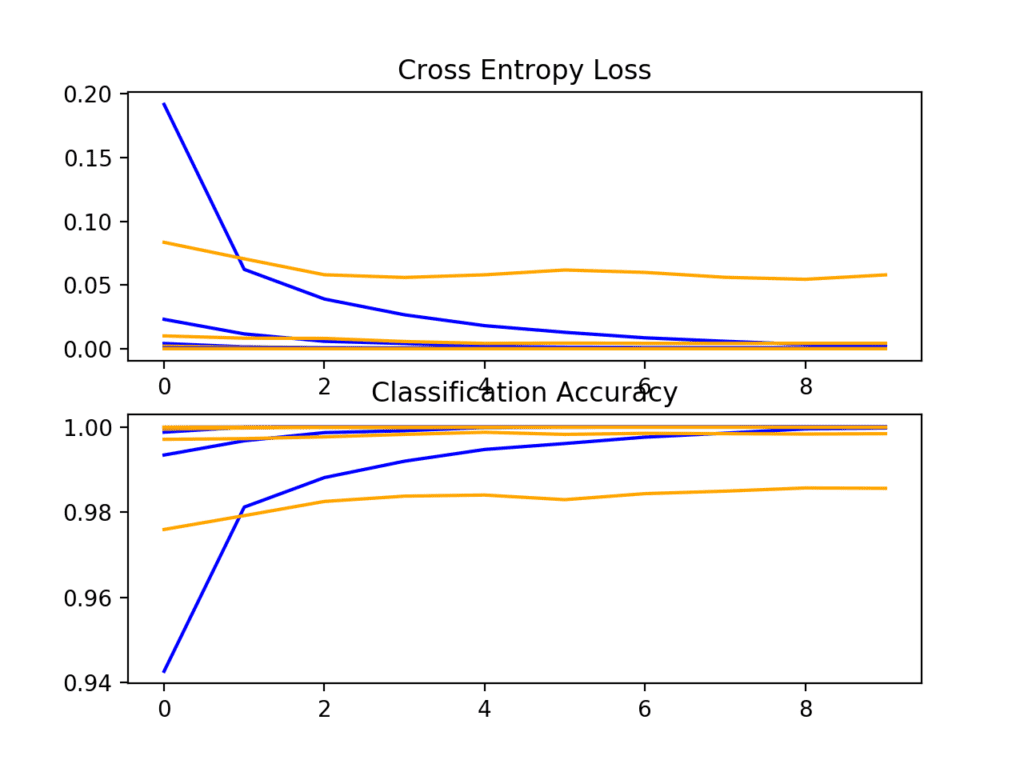
Loss and Accuracy Learning Curves for the Baseline Model During k-Fold Cross-Validation
Next, a summary of the model performance is calculated. We can see in this case, the model has an estimated skill of about 99.6%, which is impressive, although it has a high standard deviation of about half a percent.
Accuracy: mean=99.678 std=0.563, n=5
Finally, a box and whisker plot is created to summarize the distribution of accuracy scores.
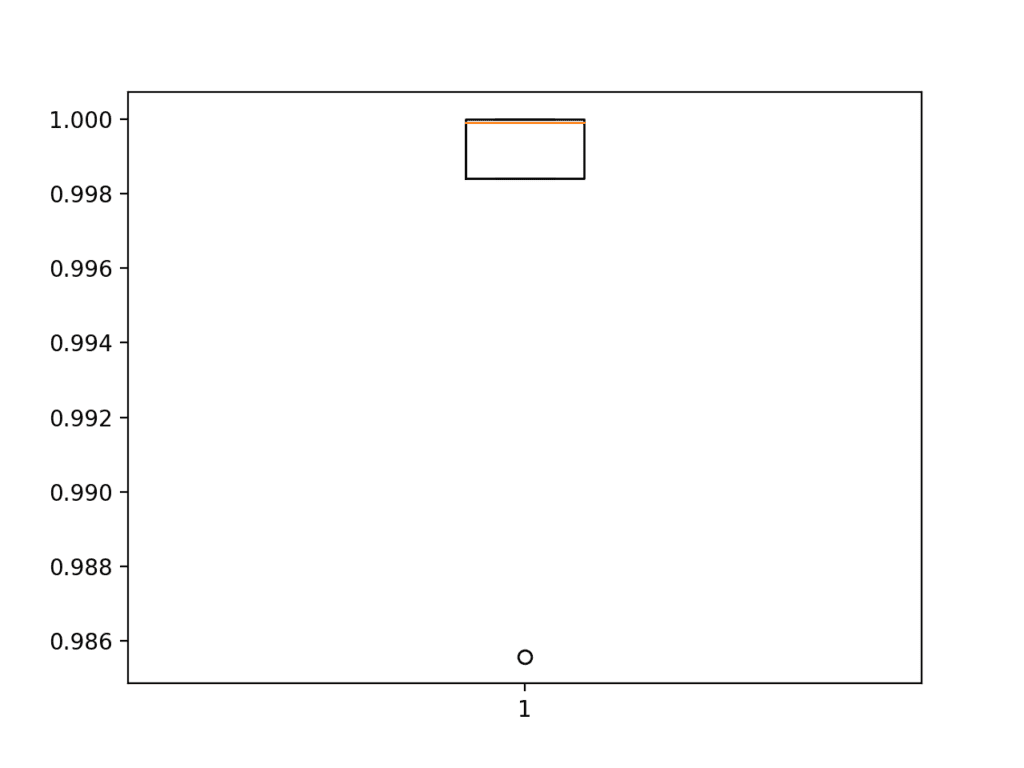
Box and Whisker Plot of Accuracy Scores for the Baseline Model Evaluated Using k-Fold Cross-Validation
As we would expect, the distribution is tight, above 99.8% accuracy, with one outlier result.
We now have a robust test harness and a well-performing baseline model.
How to Develop an Improved Model
There are many ways that we might explore improvements to the baseline model.
We will look at areas of model configuration that often result in an improvement, so-called low-hanging fruit. The first is a change to the learning algorithm, and the second is an increase in the depth of the model.
Improvement to Learning
There are many aspects of the learning algorithm that can be explored for improvement.
Perhaps the point of biggest leverage is the learning rate, such as evaluating the impact that smaller or larger values of the learning rate may have, as well as schedules that change the learning rate during training.
Another approach that can rapidly accelerate the learning of a model and can result in large performance improvements is batch normalization. We will evaluate the effect that batch normalization has on our baseline model.
Batch normalization can be used after convolutional and fully connected layers. It has the effect of changing the distribution of the output of the layer, specifically by standardizing the outputs. This has the effect of stabilizing and accelerating the learning process.
We can update the model definition to use batch normalization after the activation function for the convolutional and dense layers of our baseline model. The updated version of define_model() function with batch normalization is listed below.
# define cnn model def define_model(): model = Sequential() model.add(Conv2D(32, (3, 3), activation='relu', kernel_initializer='he_uniform', input_shape=(28, 28, 1))) model.add(BatchNormalization()) model.add(MaxPooling2D((2, 2))) model.add(Flatten()) model.add(Dense(100, activation='relu', kernel_initializer='he_uniform')) model.add(BatchNormalization()) model.add(Dense(10, activation='softmax')) # compile model opt = SGD(lr=0.01, momentum=0.9) model.compile(optimizer=opt, loss='categorical_crossentropy', metrics=['accuracy']) return model
The complete code listing with this change is provided below.
# cnn model with batch normalization for mnist
from numpy import mean
from numpy import std
from matplotlib import pyplot
from sklearn.model_selection import KFold
from keras.datasets import mnist
from keras.utils import to_categorical
from keras.models import Sequential
from keras.layers import Conv2D
from keras.layers import MaxPooling2D
from keras.layers import Dense
from keras.layers import Flatten
from keras.optimizers import SGD
from keras.layers import BatchNormalization
# load train and test dataset
def load_dataset():
# load dataset
(trainX, trainY), (testX, testY) = mnist.load_data()
# reshape dataset to have a single channel
trainX = trainX.reshape((trainX.shape[0], 28, 28, 1))
testX = testX.reshape((testX.shape[0], 28, 28, 1))
# one hot encode target values
trainY = to_categorical(trainY)
testY = to_categorical(testY)
return trainX, trainY, testX, testY
# scale pixels
def prep_pixels(train, test):
# convert from integers to floats
train_norm = train.astype('float32')
test_norm = test.astype('float32')
# normalize to range 0-1
train_norm = train_norm / 255.0
test_norm = test_norm / 255.0
# return normalized images
return train_norm, test_norm
# define cnn model
def define_model():
model = Sequential()
model.add(Conv2D(32, (3, 3), activation='relu', kernel_initializer='he_uniform', input_shape=(28, 28, 1)))
model.add(BatchNormalization())
model.add(MaxPooling2D((2, 2)))
model.add(Flatten())
model.add(Dense(100, activation='relu', kernel_initializer='he_uniform'))
model.add(BatchNormalization())
model.add(Dense(10, activation='softmax'))
# compile model
opt = SGD(lr=0.01, momentum=0.9)
model.compile(optimizer=opt, loss='categorical_crossentropy', metrics=['accuracy'])
return model
# evaluate a model using k-fold cross-validation
def evaluate_model(model, dataX, dataY, n_folds=5):
scores, histories = list(), list()
# prepare cross validation
kfold = KFold(n_folds, shuffle=True, random_state=1)
# enumerate splits
for train_ix, test_ix in kfold.split(dataX):
# select rows for train and test
trainX, trainY, testX, testY = dataX[train_ix], dataY[train_ix], dataX[test_ix], dataY[test_ix]
# fit model
history = model.fit(trainX, trainY, epochs=10, batch_size=32, validation_data=(testX, testY), verbose=0)
# evaluate model
_, acc = model.evaluate(testX, testY, verbose=0)
print('> %.3f' % (acc * 100.0))
# stores scores
scores.append(acc)
histories.append(history)
return scores, histories
# plot diagnostic learning curves
def summarize_diagnostics(histories):
for i in range(len(histories)):
# plot loss
pyplot.subplot(211)
pyplot.title('Cross Entropy Loss')
pyplot.plot(histories[i].history['loss'], color='blue', label='train')
pyplot.plot(histories[i].history['val_loss'], color='orange', label='test')
# plot accuracy
pyplot.subplot(212)
pyplot.title('Classification Accuracy')
pyplot.plot(histories[i].history['acc'], color='blue', label='train')
pyplot.plot(histories[i].history['val_acc'], color='orange', label='test')
pyplot.show()
# summarize model performance
def summarize_performance(scores):
# print summary
print('Accuracy: mean=%.3f std=%.3f, n=%d' % (mean(scores)*100, std(scores)*100, len(scores)))
# box and whisker plots of results
pyplot.boxplot(scores)
pyplot.show()
# run the test harness for evaluating a model
def run_test_harness():
# load dataset
trainX, trainY, testX, testY = load_dataset()
# prepare pixel data
trainX, testX = prep_pixels(trainX, testX)
# define model
model = define_model()
# evaluate model
scores, histories = evaluate_model(model, trainX, trainY)
# learning curves
summarize_diagnostics(histories)
# summarize estimated performance
summarize_performance(scores)
# entry point, run the test harness
run_test_harness()
Running the example again reports model performance for each fold of the cross-validation process.
We can see perhaps a small drop in model performance as compared to the baseline across the cross-validation folds.
> 98.592 > 99.792 > 99.933 > 99.992 > 99.983
A plot of the learning curves is created, in this case showing that the speed of learning (improvement over epochs) does not appear to be different from the baseline model.
The plots suggest that batch normalization, at least as implemented in this case, does not offer any benefit.
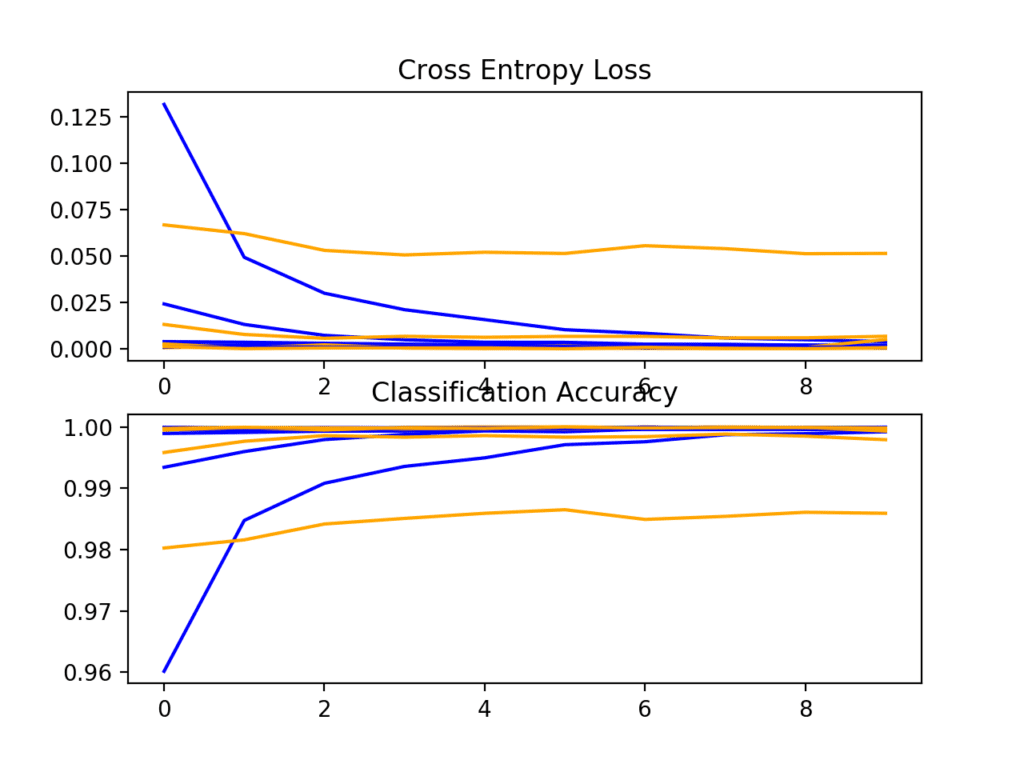
Loss and Accuracy Learning Curves for the BatchNormalization Model During k-Fold Cross-Validation
Next, the estimated performance of the model is presented, showing performance with a slight decrease in the mean accuracy of the model: 99.658 as compared to 99.678 with the baseline model, but perhaps a small decrease in the standard deviation.
Accuracy: mean=99.658 std=0.538, n=5
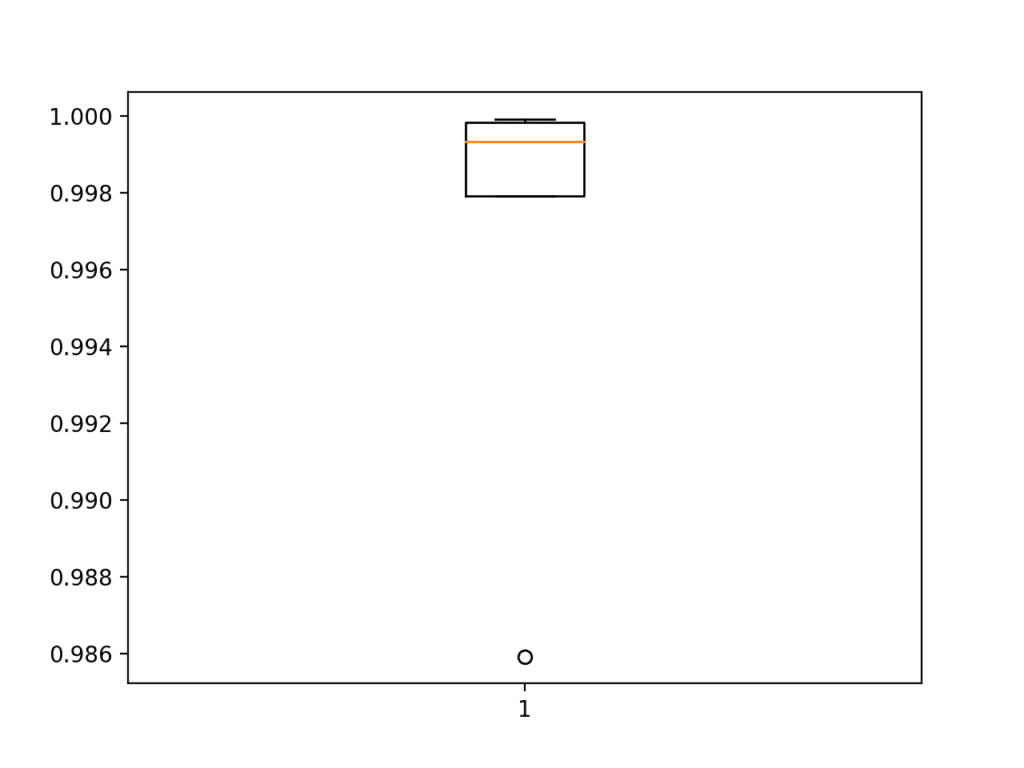
Box and Whisker Plot of Accuracy Scores for the BatchNormalization Model Evaluated Using k-Fold Cross-Validation
Increase in Model Depth
There are many ways to change the model configuration in order to explore improvements over the baseline model.
Two common approaches involve changing the capacity of the feature extraction part of the model or changing the capacity or function of the classifier part of the model. Perhaps the point of biggest influence is a change to the feature extractor.
We can increase the depth of the feature extractor part of the model, following a VGG-like pattern of adding more convolutional and pooling layers with the same sized filter, while increasing the number of filters. In this case, we will add a double convolutional layer with 64 filters each, followed by another max pooling layer.
The updated version of the define_model() function with this change is listed below.
# define cnn model def define_model(): model = Sequential() model.add(Conv2D(32, (3, 3), activation='relu', kernel_initializer='he_uniform', input_shape=(28, 28, 1))) model.add(MaxPooling2D((2, 2))) model.add(Conv2D(64, (3, 3), activation='relu', kernel_initializer='he_uniform')) model.add(Conv2D(64, (3, 3), activation='relu', kernel_initializer='he_uniform')) model.add(MaxPooling2D((2, 2))) model.add(Flatten()) model.add(Dense(100, activation='relu', kernel_initializer='he_uniform')) model.add(Dense(10, activation='softmax')) # compile model opt = SGD(lr=0.01, momentum=0.9) model.compile(optimizer=opt, loss='categorical_crossentropy', metrics=['accuracy']) return model
For completeness, the entire code listing, including this change, is provided below.
# deeper cnn model for mnist
from numpy import mean
from numpy import std
from matplotlib import pyplot
from sklearn.model_selection import KFold
from keras.datasets import mnist
from keras.utils import to_categorical
from keras.models import Sequential
from keras.layers import Conv2D
from keras.layers import MaxPooling2D
from keras.layers import Dense
from keras.layers import Flatten
from keras.optimizers import SGD
# load train and test dataset
def load_dataset():
# load dataset
(trainX, trainY), (testX, testY) = mnist.load_data()
# reshape dataset to have a single channel
trainX = trainX.reshape((trainX.shape[0], 28, 28, 1))
testX = testX.reshape((testX.shape[0], 28, 28, 1))
# one hot encode target values
trainY = to_categorical(trainY)
testY = to_categorical(testY)
return trainX, trainY, testX, testY
# scale pixels
def prep_pixels(train, test):
# convert from integers to floats
train_norm = train.astype('float32')
test_norm = test.astype('float32')
# normalize to range 0-1
train_norm = train_norm / 255.0
test_norm = test_norm / 255.0
# return normalized images
return train_norm, test_norm
# define cnn model
def define_model():
model = Sequential()
model.add(Conv2D(32, (3, 3), activation='relu', kernel_initializer='he_uniform', input_shape=(28, 28, 1)))
model.add(MaxPooling2D((2, 2)))
model.add(Conv2D(64, (3, 3), activation='relu', kernel_initializer='he_uniform'))
model.add(Conv2D(64, (3, 3), activation='relu', kernel_initializer='he_uniform'))
model.add(MaxPooling2D((2, 2)))
model.add(Flatten())
model.add(Dense(100, activation='relu', kernel_initializer='he_uniform'))
model.add(Dense(10, activation='softmax'))
# compile model
opt = SGD(lr=0.01, momentum=0.9)
model.compile(optimizer=opt, loss='categorical_crossentropy', metrics=['accuracy'])
return model
# evaluate a model using k-fold cross-validation
def evaluate_model(model, dataX, dataY, n_folds=5):
scores, histories = list(), list()
# prepare cross validation
kfold = KFold(n_folds, shuffle=True, random_state=1)
# enumerate splits
for train_ix, test_ix in kfold.split(dataX):
# select rows for train and test
trainX, trainY, testX, testY = dataX[train_ix], dataY[train_ix], dataX[test_ix], dataY[test_ix]
# fit model
history = model.fit(trainX, trainY, epochs=10, batch_size=32, validation_data=(testX, testY), verbose=0)
# evaluate model
_, acc = model.evaluate(testX, testY, verbose=0)
print('> %.3f' % (acc * 100.0))
# stores scores
scores.append(acc)
histories.append(history)
return scores, histories
# plot diagnostic learning curves
def summarize_diagnostics(histories):
for i in range(len(histories)):
# plot loss
pyplot.subplot(211)
pyplot.title('Cross Entropy Loss')
pyplot.plot(histories[i].history['loss'], color='blue', label='train')
pyplot.plot(histories[i].history['val_loss'], color='orange', label='test')
# plot accuracy
pyplot.subplot(212)
pyplot.title('Classification Accuracy')
pyplot.plot(histories[i].history['acc'], color='blue', label='train')
pyplot.plot(histories[i].history['val_acc'], color='orange', label='test')
pyplot.show()
# summarize model performance
def summarize_performance(scores):
# print summary
print('Accuracy: mean=%.3f std=%.3f, n=%d' % (mean(scores)*100, std(scores)*100, len(scores)))
# box and whisker plots of results
pyplot.boxplot(scores)
pyplot.show()
# run the test harness for evaluating a model
def run_test_harness():
# load dataset
trainX, trainY, testX, testY = load_dataset()
# prepare pixel data
trainX, testX = prep_pixels(trainX, testX)
# define model
model = define_model()
# evaluate model
scores, histories = evaluate_model(model, trainX, trainY)
# learning curves
summarize_diagnostics(histories)
# summarize estimated performance
summarize_performance(scores)
# entry point, run the test harness
run_test_harness()
Running the example reports model performance for each fold of the cross-validation process.
The per-fold scores may suggest some improvement over the baseline.
> 98.925 > 99.867 > 99.983 > 99.992 > 100.000
A plot of the learning curves is created, in this case showing that the models still have a good fit on the problem, with no clear signs of overfitting. The plots may even suggest that further training epochs could be helpful.
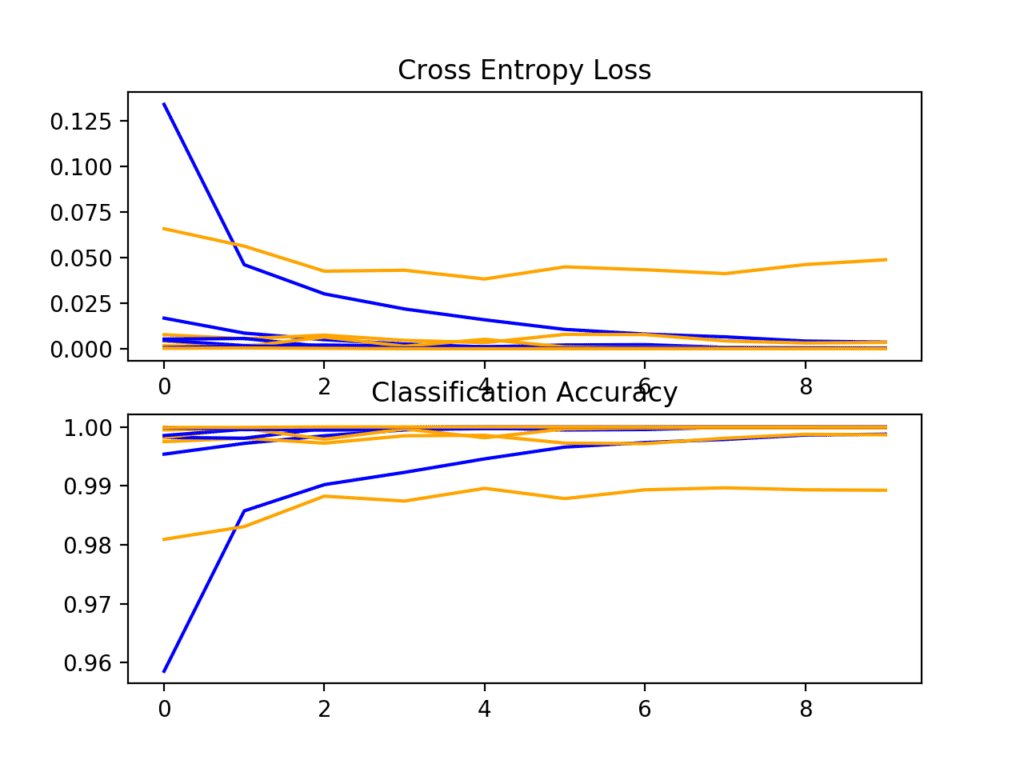
Loss and Accuracy Learning Curves for the Deeper Model During k-Fold Cross-Validation
Next, the estimated performance of the model is presented, showing a small improvement in performance as compared to the baseline from 99.678 to 99.753, with a small drop in the standard deviation as well.
Accuracy: mean=99.753 std=0.417, n=5
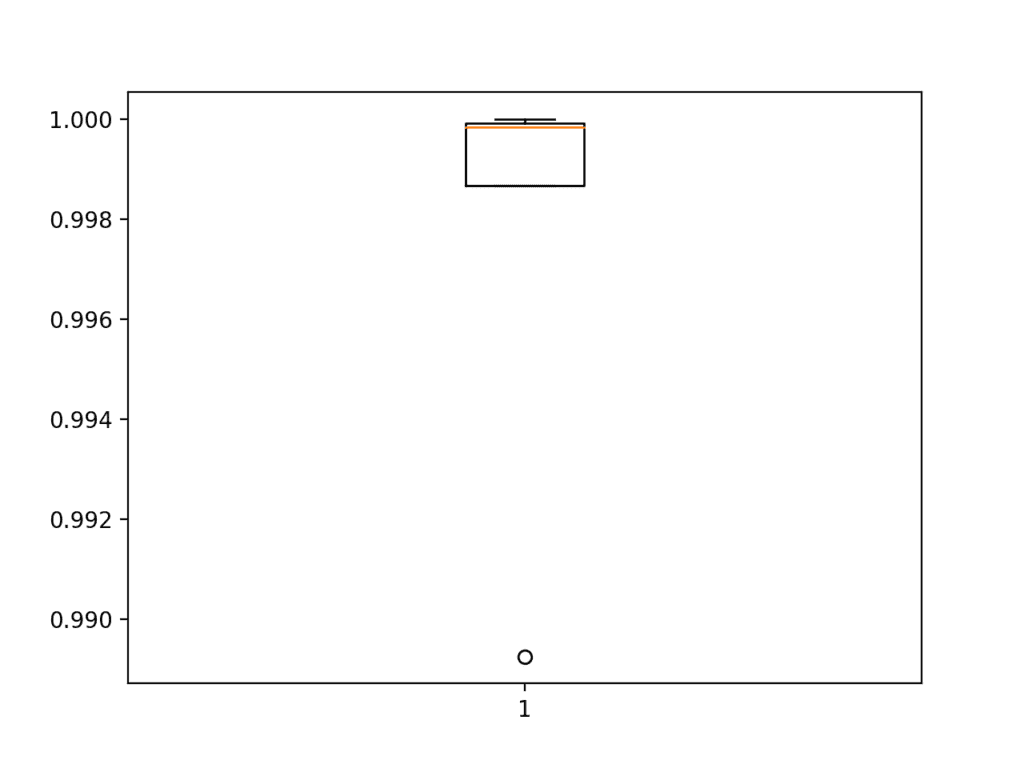
Box and Whisker Plot of Accuracy Scores for the Deeper Model Evaluated Using k-Fold Cross-Validation
How to Finalize the Model and Make Predictions
The process of model improvement may continue for as long as we have ideas and the time and resources to test them out.
At some point, a final model configuration must be chosen and adopted. In this case, we will choose the deeper model as our final model.
First, we will finalize our model, but fitting a model on the entire training dataset and saving the model to file for later use. We will then load the model and evaluate its performance on the hold out test dataset to get an idea of how well the chosen model actually performs in practice. Finally, we will use the saved model to make a prediction on a single image.
Save Final Model
A final model is typically fit on all available data, such as the combination of all train and test dataset.
In this tutorial, we are intentionally holding back a test dataset so that we can estimate the performance of the final model, which can be a good idea in practice. As such, we will fit our model on the training dataset only.
# fit model model.fit(trainX, trainY, epochs=10, batch_size=32, verbose=0)
Once fit, we can save the final model to an H5 file by calling the save() function on the model and pass in the chosen filename.
# save model
model.save('final_model.h5')
Note, saving and loading a Keras model requires that the h5py library is installed on your workstation.
The complete example of fitting the final deep model on the training dataset and saving it to file is listed below.
# save the final model to file
from keras.datasets import mnist
from keras.utils import to_categorical
from keras.models import Sequential
from keras.layers import Conv2D
from keras.layers import MaxPooling2D
from keras.layers import Dense
from keras.layers import Flatten
from keras.optimizers import SGD
# load train and test dataset
def load_dataset():
# load dataset
(trainX, trainY), (testX, testY) = mnist.load_data()
# reshape dataset to have a single channel
trainX = trainX.reshape((trainX.shape[0], 28, 28, 1))
testX = testX.reshape((testX.shape[0], 28, 28, 1))
# one hot encode target values
trainY = to_categorical(trainY)
testY = to_categorical(testY)
return trainX, trainY, testX, testY
# scale pixels
def prep_pixels(train, test):
# convert from integers to floats
train_norm = train.astype('float32')
test_norm = test.astype('float32')
# normalize to range 0-1
train_norm = train_norm / 255.0
test_norm = test_norm / 255.0
# return normalized images
return train_norm, test_norm
# define cnn model
def define_model():
model = Sequential()
model.add(Conv2D(32, (3, 3), activation='relu', kernel_initializer='he_uniform', input_shape=(28, 28, 1)))
model.add(MaxPooling2D((2, 2)))
model.add(Conv2D(64, (3, 3), activation='relu', kernel_initializer='he_uniform'))
model.add(Conv2D(64, (3, 3), activation='relu', kernel_initializer='he_uniform'))
model.add(MaxPooling2D((2, 2)))
model.add(Flatten())
model.add(Dense(100, activation='relu', kernel_initializer='he_uniform'))
model.add(Dense(10, activation='softmax'))
# compile model
opt = SGD(lr=0.01, momentum=0.9)
model.compile(optimizer=opt, loss='categorical_crossentropy', metrics=['accuracy'])
return model
# run the test harness for evaluating a model
def run_test_harness():
# load dataset
trainX, trainY, testX, testY = load_dataset()
# prepare pixel data
trainX, testX = prep_pixels(trainX, testX)
# define model
model = define_model()
# fit model
model.fit(trainX, trainY, epochs=10, batch_size=32, verbose=0)
# save model
model.save('final_model.h5')
# entry point, run the test harness
run_test_harness()
After running this example, you will now have a 1.2-megabyte file with the name ‘final_model.h5‘ in your current working directory.
Evaluate Final Model
We can now load the final model and evaluate it on the hold out test dataset.
This is something we might do if we were interested in presenting the performance of the chosen model to project stakeholders.
The model can be loaded via the load_model() function.
The complete example of loading the saved model and evaluating it on the test dataset is listed below.
# evaluate the deep model on the test dataset
from keras.datasets import mnist
from keras.models import load_model
from keras.utils import to_categorical
# load train and test dataset
def load_dataset():
# load dataset
(trainX, trainY), (testX, testY) = mnist.load_data()
# reshape dataset to have a single channel
trainX = trainX.reshape((trainX.shape[0], 28, 28, 1))
testX = testX.reshape((testX.shape[0], 28, 28, 1))
# one hot encode target values
trainY = to_categorical(trainY)
testY = to_categorical(testY)
return trainX, trainY, testX, testY
# scale pixels
def prep_pixels(train, test):
# convert from integers to floats
train_norm = train.astype('float32')
test_norm = test.astype('float32')
# normalize to range 0-1
train_norm = train_norm / 255.0
test_norm = test_norm / 255.0
# return normalized images
return train_norm, test_norm
# run the test harness for evaluating a model
def run_test_harness():
# load dataset
trainX, trainY, testX, testY = load_dataset()
# prepare pixel data
trainX, testX = prep_pixels(trainX, testX)
# load model
model = load_model('final_model.h5')
# evaluate model on test dataset
_, acc = model.evaluate(testX, testY, verbose=0)
print('> %.3f' % (acc * 100.0))
# entry point, run the test harness
run_test_harness()
Running the example loads the saved model and evaluates the model on the hold out test dataset.
The classification accuracy for the model on the test dataset is calculated and printed. In this case, we can see that the model achieved an accuracy of 99.090%, or just less than 1%, which is not bad at all and reasonably close to the estimated 99.753% with a standard deviation of about half a percent (e.g. 99% of scores).
> 99.090
Make Prediction
We can use our saved model to make a prediction on new images.
The model assumes that new images are grayscale, that they have been aligned so that one image contains one centered handwritten digit, and that the size of the image is square with the size 28×28 pixels.
Below is an image extracted from the MNIST test dataset. You can save it in your current working directory with the filename ‘sample_image.png‘.

Sample Handwritten Digit
We will pretend this is an entirely new and unseen image, prepared in the required way, and see how we might use our saved model to predict the integer that the image represents (e.g. we expect “7“).
First, we can load the image, force it to be in grayscale format, and force the size to be 28×28 pixels. The loaded image can then be resized to have a single channel and represent a single sample in a dataset. The load_image() function implements this and will return the loaded image ready for classification.
Importantly, the pixel values are prepared in the same way as the pixel values were prepared for the training dataset when fitting the final model, in this case, normalized.
# load and prepare the image
def load_image(filename):
# load the image
img = load_img(filename, grayscale=True, target_size=(28, 28))
# convert to array
img = img_to_array(img)
# reshape into a single sample with 1 channel
img = img.reshape(1, 28, 28, 1)
# prepare pixel data
img = img.astype('float32')
img = img / 255.0
return img
Next, we can load the model as in the previous section and call the predict_classes() function to predict the digit that the image represents.
# predict the class digit = model.predict_classes(img)
The complete example is listed below.
# make a prediction for a new image.
from keras.preprocessing.image import load_img
from keras.preprocessing.image import img_to_array
from keras.models import load_model
# load and prepare the image
def load_image(filename):
# load the image
img = load_img(filename, grayscale=True, target_size=(28, 28))
# convert to array
img = img_to_array(img)
# reshape into a single sample with 1 channel
img = img.reshape(1, 28, 28, 1)
# prepare pixel data
img = img.astype('float32')
img = img / 255.0
return img
# load an image and predict the class
def run_example():
# load the image
img = load_image('sample_image.png')
# load model
model = load_model('final_model.h5')
# predict the class
digit = model.predict_classes(img)
print(digit[0])
# entry point, run the example
run_example()
Running the example first loads and prepares the image, loads the model, and then correctly predicts that the loaded image represents the digit ‘7‘.
7
Extensions
This section lists some ideas for extending the tutorial that you may wish to explore.
- Tune Pixel Scaling. Explore how alternate pixel scaling methods impact model performance as compared to the baseline model, including centering and standardization.
- Tune the Learning Rate. Explore how different learning rates impact the model performance as compared to the baseline model, such as 0.001 and 0.0001.
- Tune Model Depth. Explore how adding more layers to the model impact the model performance as compared to the baseline model, such as another block of convolutional and pooling layers or another dense layer in the classifier part of the model.
If you explore any of these extensions, I’d love to know.
Post your findings in the comments below.
Further Reading
This section provides more resources on the topic if you are looking to go deeper.
APIs
Articles
Summary
In this tutorial, you discovered how to develop a convolutional neural network for handwritten digit classification from scratch.
Specifically, you learned:
- How to develop a test harness to develop a robust evaluation of a model and establish a baseline of performance for a classification task.
- How to explore extensions to a baseline model to improve learning and model capacity.
- How to develop a finalized model, evaluate the performance of the final model, and use it to make predictions on new images.
Do you have any questions?
Ask your questions in the comments below and I will do my best to answer.
The post How to Develop a Convolutional Neural Network From Scratch for MNIST Handwritten Digit Classification appeared first on Machine Learning Mastery.
